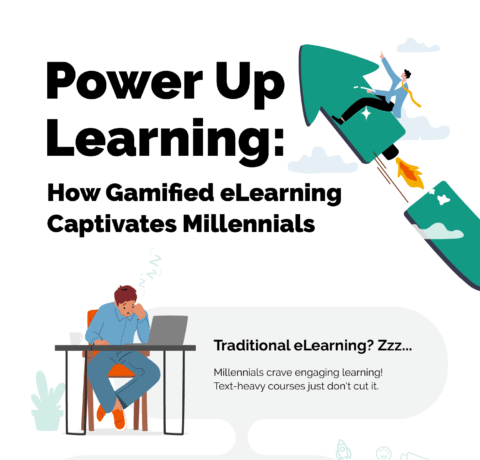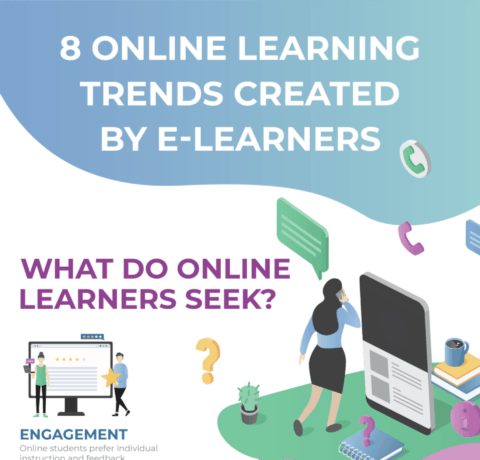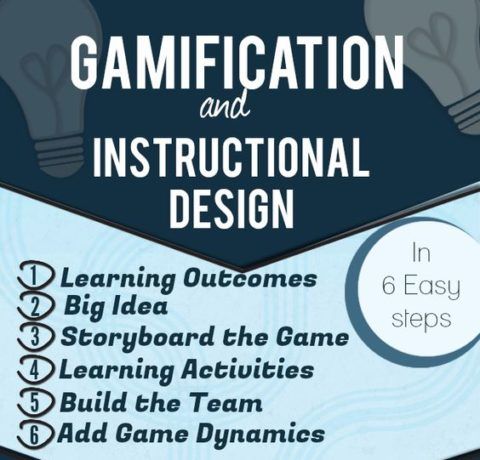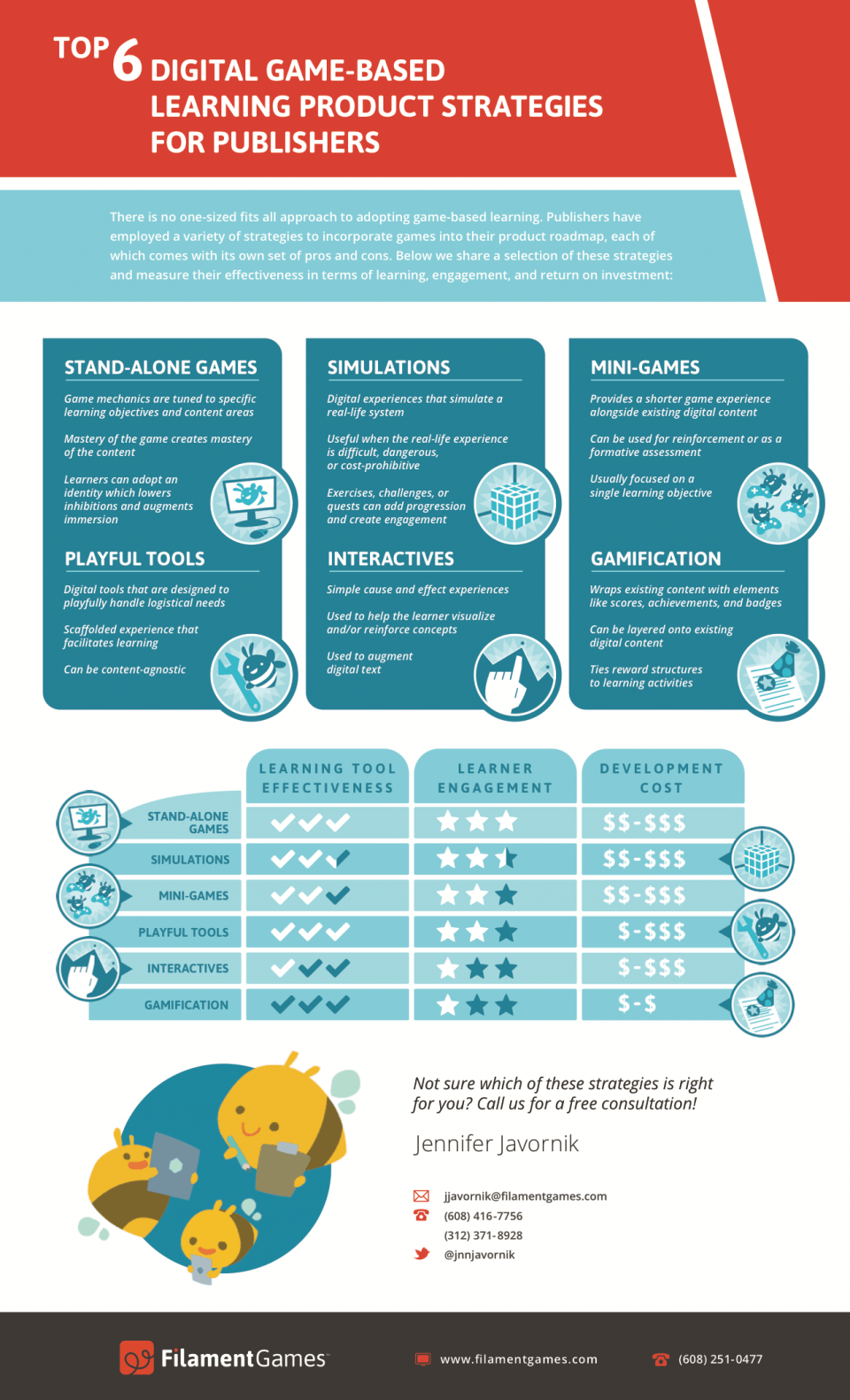Digital Game-based Learning Product Strategies for Publishers Infographic
There is no one-size fits all approach to adopting game-based learning and publishers have employed an array of strategies to incorporate games into their product roadmap. Each approach has pros and cons in terms of learning effectiveness, learner engagement, and return-on-investment, and there are lots of feature considerations that impact the final product. Below are a few examples of digital game-based learning product strategies for Publishers.
Immersive Stand-alone Games
At the top of the list are immersive stand-alone games that are either meant to be played during a classroom period or at home, with the ability to serve both of these environments as needed. These are games with deep gameplay systems where the game mechanics are tuned to the learning objectives. When structured successfully, this means that as the learner gets better at the game, they demonstrate greater evidence of mastery. These games often allow the learner to adopt a new identity, leveraging the learning benefits of experiencing different epistemic frames.
From a learning perspective, there is a significant body of research that demonstrates the effectiveness of immersive games to drive both efficacy and engagement. By their very nature, immersive games have the added benefit of developing highly sought-after 21st Century skills, because they inherently require players to leverage skills like problem solving, critical thinking, and collaboration. Some publishers sell these games as their own stand-alone product line while others offer them as part of a broader product offering, as McGraw-Hill did with its Inspire Science solution. These games are at the top of the cost range, but also offer the highest value in terms of delivering on a variety of specific learning outcomes.
Simulations
Simulations are digital experiences that simulate or mimic a real-life system. Simulations are useful when the real-life experience is difficult, dangerous, or cost-prohibitive in the real world. Beyond the objective of a straightforward simulation of a system, this type of experience can be augmented with scaffolding to improve efficacy outcomes. That scaffolding can take the form of well-conceived exercises, challenges, or quests so that learners can further explore the subject matter in ways they might not consider themselves. We took this approach when we developed Wavequest for the US Office of Naval Research, a submarine sonar equipment simulation that is augmented with goal-oriented challenges. The cost to develop simulations will vary based on the complexity of the system being represented, the fidelity of the simulation, and whether or not a quest or challenge system is added.
Mini-Games Interspersed in Digital Product
When a product covers a broad range of digital content, publishers often prefer an approach where the learner gets to experience a short game experience with every unit or chapter. A good example of a well-implemented mini-game strategy is SuperKids Online Fun! which we created for Zaner-Bloser. Mini-games can be approached as a content-reinforcement tool, a content-exploration tool or as a formative assessment tool. The experience usually targets a single learning objective, which can be effective for reinforcing skills but is less well suited for teaching cross-cutting concepts. We generally do not recommend using a single mini-game template to cover different content areas, as this can force the mechanics to be flat and generic at the cost of both engagement and efficacy. The development cost for mini-games is typically low, but varies based on the number of mini-games and depth of each experience.
Playful Tools
Playful tools are essentially interactive digital experiences that efficiently address specific skills and prioritize function over form while preserving the user's sense of agency and impact. Drafting Board, which we created for iCivics is a great example of a playful tool that was deemed effective by third party researchers. The tool challenges students to tackle important civic questions using primary source documents and analytical skill. The cost to develop a playful tool will vary based on the size and complexity of the tool but in general can be lower than the cost to develop a game or simulation.
Interactives
Interactives are simple cause-and-effect experiences. Click something and something happens. Move something and something else happens. With no rules, no strategy, and no goals, a digital interactive offers a limited but pointed experience. Interactives are used to help the learner visualize or reinforce a concept. For example, we created a clickable map of the United States for Worldbook Encyclopedia to help learners visualize states in relation to each other. Interactives are usually not implemented as stand-alone experiences and instead augment other digital content.
Gamification
Gamification involves surrounding non-game content with game-like structures such as scores, achievements and badges. This can be an effective strategy for Publishers because you can leverage your existing investment in traditional digital content and motivate learners to use the content. Gamification done well stretches beyond the carrot-on-a-stick mentality. Gamification can allow the learner to experience the content from a unique identity and can intrinsically tie the reward structures to the learning activities. A popular example of this is Classcraft, a gamification system that adds avatars, quests, and achievements that wrap around the entire classroom experience. As the concept gains in popularity, the novelty of gamification systems seems to be diminishing. While it can be implemented at a relatively low cost, the value-add and effectiveness can also be limited.
In summary, publishers have a number of options to consider when deciding how to incorporate games into their product offering. We’ve prepared a handy infographic below to help you visualize these options, as well as their cost and best applications.







You can adjust your cookie preferences here.